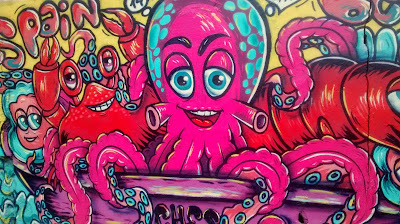Wunderground had forecast a showery day so we decided to visit Valencia's art gallery. The northern and east edges of the old city are defined by the course of the old river Turia. This dried up long ago; now it provides a green space running right through the heart of the city. The 'Museo des Bellas Artes' was about half a mile from the Metro stop 'Turia'. The El Corte Ingles department store next to the station was starting its outdoor Christmas promotion complete with snow covered chalets and giant toy soldiers. In 22 degree temperatures under a bright blue sky somehow it did not seem right.
 |
| Christmas comes early to Valencia |
 |
| Baseball, Spanish style. |
Our map had a small drawing of the art gallery on it, so it should have been easy to spot its twin stone towers. We got near to the place where it should have been but could not find it. In the process of searching for it we did come across one of Valencia's two remaining gates. The monumental size gives you some sense of the power and wealth of the place in the sixteenth century. From this vantage point across the old river it became obvious why we had lost the gallery. It was under refurbishment and the entire facade was wrapped-up in protective sheeting. No wonder it looked nothing like the graphic on the map.
 |
| The city gate |
 |
| A plethora of Virgin Marys interspersed with po-faced portraits. |
 |
| Just occasionally a more informal figure would sneak in amongst the stern faced saints and Cardinals. |
 |
| Even the dog was painted with psychological acumen! |
It was painted around 1804, towards the end of the half century we now call The Enlightenment. Though it may be unfashionable now to believe in progress, it is difficult not to regard the move from superstition to a more liberal and rational vision of the human spirit evidenced in the Goya as a definite move forward. However it was not Goya's 'big picture' that truly illustrated this.
Hanging to the right of the portrait were two small genre pieces depicting children playing - tag and leapfrog. It is these pictures that are truly revolutionary. Before this time nobody would have considered a children's simple game as a worthwhile subject for art. It struck me that these two small paintings were almost exactly contemporaneous with Wordsworth's 'Intimations of Immortality' ode. It contains the famous phrase 'the child is the father of the man'. These Romantic era artists really were pioneers of modernity, you sense that they are portraying human nature as individualistic and capable of change, not something God-given and fixed. Their views about the importance of play and childhood pre-figure a more psychological view of the human mind.
At which point we tumbled off the apex of Maslow's pyramid, landed with a bump in its nether regions of bodily need, decided we were starving, and headed into the city in search of lunch.
 |
| Never mind the culture...let's find lunch! |
After yesterday's culinary triumph in the market's Central Bar, today turned out to be a bit of a let-down. We left the gallery and headed to an old part of the city just beyond Porta de Serrans. After walking through an area of grand baroque palaces we found ourselves in a pleasant square,Placa de la Verge, just behind the cathedral. It was lined with cafés, We just made a bad choice, for the patatas bravas we ordered could not have been more different to the ones we had yesterday. These efforts were like chips covered in spicy ketchup and mayonnaise. Then there was the issue of the wandering flute playing beggars...Oh well, everything can't be top notch all the time I suppose.
 |
| Placa de la Verge |
 |
| with Gill and the Triton fountain |
 |
| Not even the olives were up to much. |
 |
| Bridge of Sighs style bridge |
 |
| beauteous lamposts |
 |
| Modernista style tiled facades |
 |
| shaded avenues |
 |
| Ok, it's a puerile joke... |
Valencia Graffiti
 |
| In amongst it all, really nice restaurants.... |
After a while we reached the ancient gate on the opposite side of the old city. This one was pock-marked with cannon balls lobbed at it by French artillery during the Peninsula War. We were both pretty weary now, and headed back to Angel Guillara metro stop.
The rain that had been forecast never materialised, well, not until we stepped-off the Metro near the Campervan Stop. Then it tipped down, so lugging cagouls around all day did prove worth it in the end.
Three wonderful days in Valencia - a lovely city, friendly locals, great food..fascinating architecture - we loved it, definitely one of the high spots of the trip so far













No comments:
Post a Comment